This wouldn’t be a proper Britishness blog if the first post wasn’t about tea and tea time in Britain.
And, yes, probably everything you’ve heard or read about the British and their tea is true; it’s a national obsession.
Of course it’s a drink, but it’s so much more – there are meals named after it; food stuffs made from it or to be eaten with it; we denote times of the day to it; we have people employed to make sure everyone’s tea needs are met in the workplace (although unfortunately this is less common nowadays due to vending machines); and there’s a whole slew of customs and traditions that dictate everything from the ‘proper’ way to make tea, to acceptable leaf strains and blends, and even the way you stir your tea when in ‘polite society’.
Types of Tea
How To Make A Perfect Cup Of Tea
Tea Times of the Day
Etiquette for Afternoon Tea
The Great Teatime Debates
But why do the British seem to worship all things tea?
Well, it’s obvious; it’s because there isn’t a problem, no matter how big or small, that a cup of tea won’t make at least a little better, and there are no happy times that tea won’t make that little bit more perfect. If you’re cold, tea warms you. If you’re hot, tea cools you. If you’re sick tea nurses you. If you’re sad tea gives you a hug. If you’re angry, tea wipes your brow. If you’re celebrating, tea shouts ‘Hurray!’ We all know these to be facts.
Tea time in Britain is almost anytime, and ‘Put the kettle’ and ‘Fancy a cuppa?’ are probably amongst the most common words heard up and down the country every day. If you hadn’t guessed, ’fancy a cuppa?’ means ‘would you like a cup of tea?’, to which you’ll usually hear the reply, ‘I’d love one’, or the more dramatic, ‘Oh, I could murder one’.
TYPES OF TEA
To a Brit, ‘tea’ is always black tea with milk. If you mean green tea, you say ’green tea, if you mean chamomile tea, you say ‘chamomile tea’ and so on. So if you say ‘tea’, to a Brit it will be taken to mean black tea with a little milk – no slice of lemon, no omitting the milk, no straws, no flowers, no petals or other decorative shrubbery to make it look Instagram pretty.
TYPES OF BLACK TEA
All black tea comes from one plant, Camellia sinensi, but there are approximately 1500 different types of black tea sold in Britain, and most British people have their own favourite type and brand.
The taste, strength, colour and aroma all depend on many factors including the plant variety, the country, region or even estate where it was grown, the season it was harvested, the processing methods, and so on.
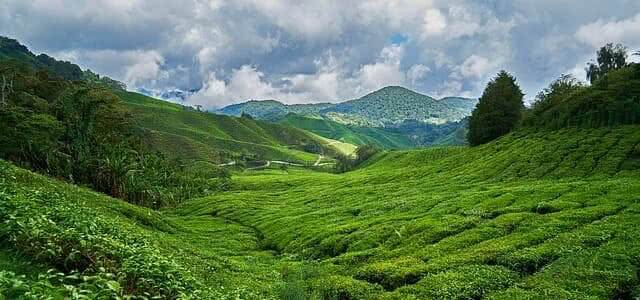
Tea Plantation
Black tea is generally dark reddish-brown in colour from the oxidising process, rich in tannins and with a fair amount of caffeine.
The most common types of black tea you’ll find in Britain, which are drunk on a daily basis are:
ASSAM TEA
Grown in north eastern India, mostly at or near sea level. It is a strong, dark, full-bodied tea with a malty flavour. It can be found in many blends or used as a single ingredient. Originally Britain got it’s tea from China but during the Opium wars supply was disrupted so The British East India Company began producing tea in the Assam region of India, hence the name.
CEYLON TEA
Grown in the mountains of Sri Lanka, in regions from 2500 to 6000 feet above sea level and therefore it can vary greatly in flavour. It is crisper and lighter in colour and taste than Assam although it’s still a strong robust tea.
DARJEELING TEA
Originally from Nepal, it’s grown in the Himalayan foothills of northern India, in the province after which it is named. It is full bodied yet has a delicate flavour with a light bouquet and is light in colour. It is considered by many to be the champagne of teas and is often the tea of choice for Afternoon Tea (see below).
KENYAN TEA
Of the Assamica variety but due to the soil and climactic conditions where it is grown in Kenya, a lighter, redder coloured tea results that is less bitter than the Indian grown harvests. It is mostly grown and processed by small family holdings rather than large companies.
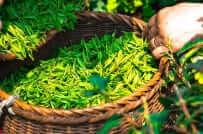
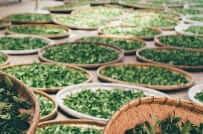
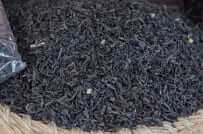
Tea leaves at various stages of processing – freshly harvested, sun drying, dried leaves
TEA BLENDS
As well as different types of black tea, there are different tea blends that are popular in Britain. A blend is a mix of different teas. The most popular include:
ENGLISH BREAKFAST TEA is a blend of Assam, Ceylon, and Kenya black teas which produces a strong, dark brew with high caffeine content. Despite its name it originated in Scotland where it was known simply as ‘breakfast tea’. It is said that Queen Victoria was served it whilst visiting Balmoral and liked it so much that she took it back to London with her, where its popularity grew and it became known as English Breakfast tea.
EARL GREY TEA is a blend of black teas that are flavoured with bergamot oil – a type of orange fruit found in France and Italy. There are various stories attached to the creation of this now very popular blend, all involving Charles Grey, the 2nd Earl Grey who was British Prime Minister from 1830 – 1834. Most likely, as was common in those days, it was specially blended by a Chinese tea merchant. Some suggest this was to combat the lime heavy water at the Grey family home in Northumberland whilst others say it was in way of repaying a debt to the Earl.
LAPSANG SOUCHONG comes from the Fujian region of China. It is said to be the first black tea in history, and it is one of the most famous Chinese teas. It has a distinct smoked flavour which comes from being dried over smoking pine fires. This first came about due to the drying process having been delayed one year because armies were passing through the region.
There are many other types of black tea, but these are the most commonly consumed in Britain.
TEAPOT
Last, but not least… the teapot. It too is of course a crucial element to be able to make a perfect cup of tea.
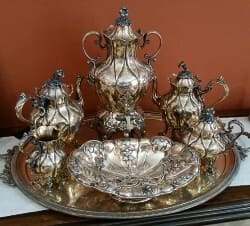
Early teapots were ornate and made of solid silver, but porcelain china is now preferred. Chine does not affect the flavour of the tea like silver does, however metal pots do have the advantage of keeping the heat in for longer, and so stainless steel tea pots are functional and popular if not as aesthetically pleasing.
After use, the inside of a teapot (at home) is rarely if ever washed with soap or scrubbed clean. Instead it will be lightly rinsed under the tap and just clean water swirled around inside. The idea is that the tannin residue should build up on the inside walls of the teapot, which may not look very attractive but adds to the flavour.
HOW TO MAKE A PERFECT CUP OF TEA
Learning how to make a perfect cup of tea couldn’t be easier.
Although shoving a teabag in a mug and pouring hot water over it is the most many of us manage consistently in our busy lives nowadays, to make a perfect cup of tea requires a teapot and loose tea, served in fine china cups.
- You need to warm the teapot before brewing the tea – pour about half a cup of boiling hot water into the teapot and swill it around a few times then discard this water. The pot is now ready.
- Put one level teaspoon of loose tea per person plus one teaspoon for the pot, into the teapot.
- Fill the teapot, or as much as required, with boiling hot water.
- Put the lid on and turn the pot three times clockwise in a circle – do this without lifting the teapot off the table or counter – to allow the tea and water to swirl and mix thoroughly.
- Put a tea-cosy on the pot and allow the tea to sit and brew for about 3 or 4 minutes.
- Pour a little milk in a tea cup then pour the tea in – remember to use a tea strainer.
- Add sugar if desired.
TIPS
- If you like stronger tea, use more tea, don’t let it brew for longer as it turns bitter.
- Use boiling hot water, as cooler water won’t allow for proper brewing.
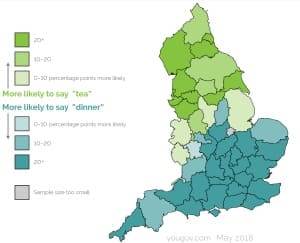
Source: yougov
TEA TIMES OF THE DAY
AFTERNOON TEA
Afternoon tea is a snack meal taken in the mid to late afternoon. It consists of sandwiches, scones served with jam and clotted cream, a variety of small cakes and of course copious amounts of tea.
The food is usually served on a tiered cake stand with the sandwiches on the bottom tier and the cakes on the top, and the order of eating is from the bottom up i.e. savoury sandwiches first.
Afternoon tea sandwiches are dainty things. Usually they are cut into thin fingers or small triangles rather than the great wedges that you’ll see at lunchtime. They’ll usually have the crusts cut off, and one of the favourite fillers is cucumber – yes, just plain dainty cucumber finger sandwiches.
Scones are somewhere between cake and bread. They are lightly sweetened, small, round and bun like, and may contain dried fruit. They are eaten with jam and cream or clotted cream – an extremely thick, dense cream.
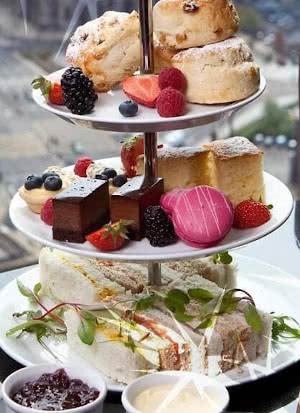
Afternoon Tea became popular during the Victorian era as a social occasion for society ladies to meet. Open house receptions would be held between 4pm and 7pm when guests could drop by, drink tea and would be offered finger foods. Tea at the time was an expensive commodity and could only be regularly indulged in by the affluent class.
Afternoon tea was also known as “low tea” because it was served on low side tables placed next to armchairs. It is said to have originated in the 1840s when the Duchess of Bedford, who was peckish one afternoon, asked her host the Duke of Rutland, for a snack of tea and sandwiches.
Nowadays Afternoon Tea is more of an occasional indulgence rather than a regular ritual, and is common as a birthday celebration.
CREAM TEA
You may also hear the term Cream Tea used. This is a simpler form of Afternoon Tea. It consists of tea served with scones, and jam and clotted cream. It does not include the sandwiches or cakes as well. It is a feature of the south-west of England, in Devon and Cornwall, where the finest, thickest clotted cream is produced.
LOW TEA
This was another term used for Afternoon Tea, as it was originally served at low side tables, as opposed to being served as a full meal at a dining table.
HIGH TEA
With the advent of the Industrial revolution in 19th century Britain, factory workers would arrive home after work at about 6pm and would have the family meal then, before the children went to bed. It was called High Tea as it was served at a dining table, and to differentiate it from ‘low tea’ which was taken on side tables. High Tea would consist of a hot meal, the main meal of the day but not always including meat, and served with tea.
Note: High Tea and Afternoon Tea are often used interchangeably – this is incorrect.
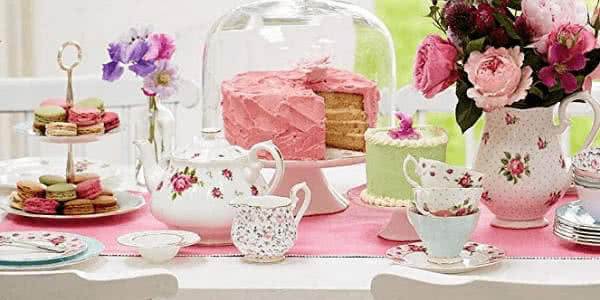
ETIQUETTE FOR AFTERNOON TEA
If you are having tea out, for example afternoon tea at a tea house, or attending a smart afternoon tea party, there are certain rules of etiquette for afternoon tea to be aware of.
Generally the host will pour tea for all those present, usually stating with the most important or most senior guest first. Alternatively, sometimes the eldest female present will offer or will be offered the privilege of ‘being mother’, meaning to pour the tea for everyone.
Never use the teaspoon from the sugar pot to stir your cup of tea with.
Never stir your tea too vigorously or scraping round the side of the cup. Stir it by placing the teaspoon in the cup at the 12 o’clock position and gently moving it backwards and forwards to the 6 o’clock position, a couple of times. Then set the spoon to rest on your saucer, to the right of the cup; never leave your spoon sitting in the cup.
Never dunk biscuits or anything else in your tea.
Never lift your little finger up in the air when drinking from your cup – this is an urban myth and does not show good manners or breeding.
If the tea is served on a low table, lift the cup and saucer together to about chest height before lifting the cup from the saucer to your mouth. If the tea is served at a dining table, lift just the cup to your mouth and leave the saucer on the table. Always bring the cup up to your mouth, not your mouth down to the cup. When not drinking, return the cup to the saucer; don’t cradle the cup.
You eat the sandwiches with your hands.
When eating scones, never put the jam or cream directly from the serving dishes onto your scone. Instead serve yourself a helping of each on to the side of your plate and from there use a knife to spread them on to your scone. The scone is then eaten with the hand.
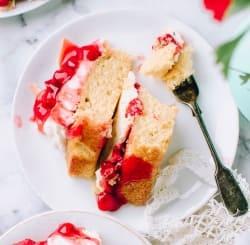
You eat the cakes with a small (cake) fork only, no knife. The fork is held up-turned in the right hand, and is used on its side to slice into the cake and cut small mouth-sized pieces.
Your napkin should sit on your lap, not tucked in to at the neck, and when you use it you dab rather than wipe your mouth.
THE GREAT TEATIME DEBATES
In the genteel world of tea time in Britain, two on-going disputes rage.
MILK FIRST OR TEA FIRST?
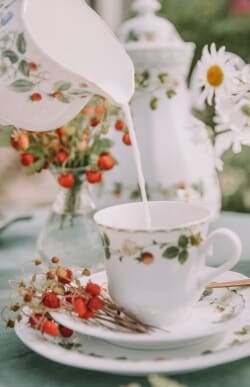
With strong feelings on both sides, the first and most hotly contested is – which should go in the cup first; the milk or the tea?
Traditionally milk was poured into the cup before the tea to prevent the delicate china cups from cracking due to the heat of the tea.
These days, as more people use mugs and teabags, and brew their tea in the mug, milk is added after the tea has brewed, because if milk is put in first the tea doesn’t brew properly.
There’s no definitive right or wrong, but whichever you prefer, expect to be challenged. If nothing else, whatever you do, never put the milk in the teapot!
JAM FIRST OR CREAM FIRST?
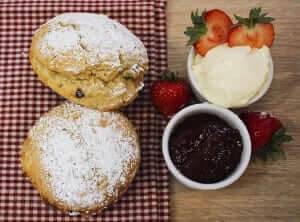
The other hotly contested tea time debate is what should go on the scone first; jam or cream?
In 2018 The Independent newspaper declared that they had evidence of the Queen’s preference. Apparently she puts the jam on first – and so a portion of the country approved of her, and themselves, a little bit more.
TEA RELATED LANGUAGE
To sound really authentic in Britain, you need to know the right ‘tea’ vocabulary.
| builders’ tea | strong tea, usually made from cheap teabags and served in a mug |
| a brew | a cup or pot of tea |
| cuppa | a cup of tea |
| dishwater | very weak tea (from the murky colour left in a bowl of water after having washed the dishes in it) |
| tea break | a short rest taken during the workday, usually to drink a cup of tea |
| teacake | a bun shaped sweet bread with dried fruit , usually served toasted and buttered. In Scotland a teacake is biscuit covered with marshmallow and chocolate. |
| tea lady | the lady employed by a company to go around the office with a tea trolley offering tea and snacks to the employees |
| tearoom | an English version of a café, selling tea, cakes and light refreshments |
| tea leaf | thief in cockney rhyming slang (and of course the literal meaning – a leaf of the tea plant) |
| teasmade | an electric tea maker that people place beside their bed, which automatically prepares tea when the alarm wakes them up in the morning |
| a splash (or dash) of milk | a little bit of milk |
| not too milky | not too much milk |
| strong enough to stand a spoon in | very strong, dark, over-brewed tea |
| put (or pop) the kettle on | to put the water on to boil (to make a cup of tea) |
| Shall I be mother? | Shall I pour the tea? |
| I could murder a cup of tea / I'd kill for a cup of tea / I'm dying for a cup of tea. | I would really like a cup of tea |
| How do you take it? | how do you like your tea i.e. strong or weak, with or without sugar, a lot or a little milk. The answer is generally ’However it comes.’ This may then followed by the personal preferences – ‘not too much milk, no sugar, quite strong.’ |
| not (one’s) cup of tea | not to (one’s) taste or preference Camping holidays are really not my cup of tea. |
| a storm in a teacup | an over-reaction of emotion over something small They're always arguing, but it's usually a storm in a tea cup. |
| not for all the tea in China | not at any price He hates shopping, he wouldn't go in to town on a Saturday for all the tea in China. |
| what’s that got to do with the price of tea? | a rhetorical question in response to an irrelevant statement made by another person |
Right, well you’re now up to speed on all things tea time in Britain.
My work here is done.
I’m off to pop the kettle on.
Tea time in Britain June 2019